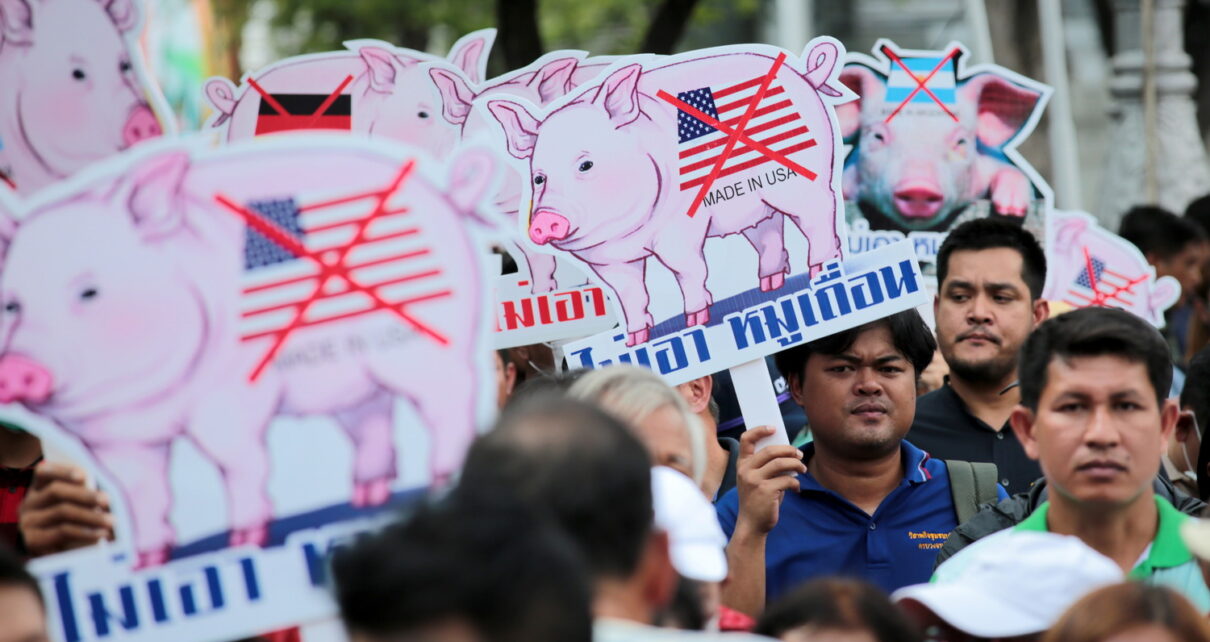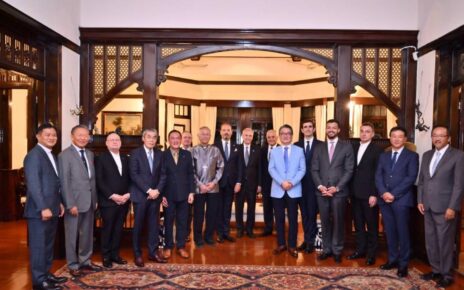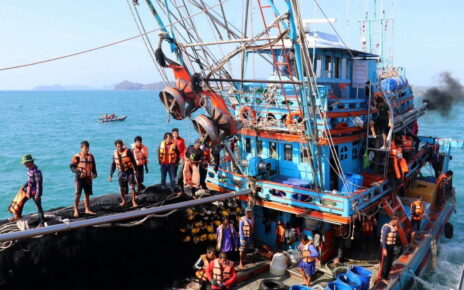Thailand’s swine industry stands firm against a government plan to import U.S. pork as part of trade deficit negotiations, warning that such a move would undermine domestic livestock farming and raise safety concerns for consumers. The proposal, introduced during discussions aimed at narrowing the U.S.-Thailand trade gap after Washington’s 36% tariff on Thai goods, has drawn a sharp rebuke from the Swine Raisers Association of Thailand. The group argues that while imports of animal feed ingredients like corn, soybeans, soybean meal, and wheat may help strengthen the growing livestock sector, bringing in U.S. pork would upend the country’s pork production system, threaten livelihoods, and jeopardize food security.
The association’s president, Sitthiphan Thanakiatpinyo, conveyed the stance in a recent address, emphasizing support for targeted imports that address shortages in animal feed components while opposing pork imports from the United States. He contends that feed ingredients needed to sustain Thailand’s expanding livestock industry are scarce and increasingly essential. Yet he warned that allowing U.S. pork would set off a chain reaction across the entire local pork ecosystem, ultimately eroding the abilities of Thai farmers to compete. The result, he warned, could be a collapse of demand for animal feed corn and a wave of job losses across farming and allied sectors, pushing Thailand to curtail its own corn imports from the United States.
The association’s argument is multi-faceted, underscoring how deeply intertwined the pork production value chain is with Thailand’s broader agricultural economy. Specifically, Sitthiphan argued that the domestic system comprises a long, interdependent supply chain spanning crop farmers, grain traders, animal feed producers, pig farmers, slaughterhouses, market butchers, and pork processors. He asserted that importing pork would disrupt every stage of this chain, risking a systemic breakdown that could threaten national food security. Drawing on international comparisons, he pointed to the Philippines as a cautionary example, where pork imports allegedly diminished local farmer motivation, precipitated a pork shortage, and increased reliance on imports—consequently elevating pork prices by a substantial margin. Sitthiphan’s warnings stressed that any policy shift must consider the long-term implications for price stability, supply reliability, and the resilience of Thailand’s agricultural economy.
In stressing consumer safety and national safeguards, Sitthiphan highlighted Thailand’s regulatory framework for pork safety, noting that Thai law prohibits leanness-enhancing agents due to potential adverse effects on human cardiovascular and nervous systems when consumed in large quantities. He argued that Thai pork embodies safer production practices compared with U.S. pork, a distinction he framed as a critical safeguard for Thai consumers. Given these considerations, he urged the government’s negotiation team—led by Deputy Prime Minister and Finance Minister Pichai Chunhavajira—to abandon the pork import proposal, warning that the policy could generate a suite of downstream problems that would be difficult to reverse.
Section 1: The government proposal and its stated objective
The current debate centers on a government proposal designed to address a broader trade imbalance with the United States. The core idea involves importing animal feed corn and meat products, notably pork, from the United States as a strategic measure to reduce the trade deficit. This approach is presented within the context of a larger negotiation framework, which includes the United States imposing a 36 percent tariff on Thai goods. The cited objective is to rebalance trade flows and create more favorable conditions for Thai exporters, while ensuring that Thailand’s own domestic industries—particularly agri-food sectors—are not economically destabilized.
Supporters of importing animal feed ingredients—such as corn, soybeans, soybean meal, and wheat—argue that these inputs are in short supply within Thailand and are increasingly needed to accommodate a growing livestock sector. They see these imports as a targeted, economically rational response to feed shortages that can bolster productivity, improve animal health, and support the expansion of pork and other livestock operations without undermining domestic producers’ competitiveness. From this viewpoint, feed inputs are a pragmatic solution that strengthens the backbone of the agricultural economy rather than a blanket liberalization that could undermine domestic production.
In contrast, the proposal to import U.S. pork is framed by opponents as a fundamental shift that would directly undermine the core of the domestic pork industry. Critics argue that allowing cheap foreign pork to enter the market would create an uneven playing field, making it nearly impossible for Thai farmers to compete on price and quality. The potential consequences extend beyond immediate profits or losses; they encompass long-term structural changes to Thailand’s pork sector, including the risk of reduced investment in local breeding stock, genetics, and farm modernization as returns diminish. The overarching concern is that such a policy would irreversibly tilt the market toward imports at the expense of domestic production, jeopardizing the livelihoods of farmers and workers across the supply chain.
Supporters of the feed-ingredient imports stress that the policy can be implemented with selective guardrails to limit exposure to imported meat while expanding access to necessary feed inputs. They argue that the shortage of essential feed components is a limiting factor for the growth of Thailand’s livestock sector—one that, if unaddressed, could cap production, constrain job creation, and hinder rural development. By differentiating between feed inputs and finished meat imports, policymakers can pursue a dual-track strategy: strengthen domestic production through improved feed availability and animal health, while addressing trade balance concerns through measured, targeted imports of specific livestock inputs.
Sitthiphan’s remarks underscore a broader strategic consideration: the need to preserve the integrity and resilience of Thailand’s agricultural value chain. He contends that the domestic pork system is built on a carefully calibrated sequence of inputs and processes—crop production, feed manufacturing, pig farming, slaughter, processing, and distribution. Any policy shift that disrupts this sequence risks cascading failures that undermine efficiency, food security, and consumer confidence. The debate, therefore, centers not just on immediate market effects but on the structural viability of Thailand’s pork industry over the long term, including opportunities for modernization, investment, and job creation within the country’s agricultural economy.
Section 2: The Swine Raisers Association of Thailand’s stance and reasoning
The Swine Raisers Association of Thailand has articulated a comprehensive, multi-layered argument against importing U.S. pork. At the heart of their position is a concern that such imports would devastate the domestic pork industry by creating an unsustainable competitive disadvantage for Thai farmers. The association emphasizes that Thai pork producers operate within a long supply chain that connects crop farmers, grain traders, animal feed producers, pig farmers, slaughterhouses, market butchers, and pork processors. Each link in this chain depends on the others for stability and profitability; a disruption at any point can reverberate through the entire system.
A central claim is that importing pork would disrupt every step of the chain, threatening the operational viability of the entire pork production ecosystem. Sitthiphan argues that this ecosystem is a cornerstone of the nation’s food security, because robust, self-sustaining pork production underpins local livelihoods and supply reliability. When a large portion of meat demand can be met through imports, domestic producers may reduce investment in breeding, technology, and efficiencies, leading to a slower modernization pace and reduced competitiveness in the long run. The association therefore frames pork import as a policy instrument with potential to erode domestic capacity to produce pork, with unintended consequences for rural employment and national food sovereignty.
Sitthiphan’s cautionary example of the Philippines highlights perceived risks tied to liberalizing pork imports. He notes that in the Philippines, pork imports purportedly dampened farmers’ motivation to continue farming, ultimately resulting in pork shortages and heightened dependence on imported meat. He cites observed price implications—specifically a rise in pork prices by the order of 15–30 percent—arguing that such price shocks can have lasting welfare impacts on Filipino consumers. While the exact causality may be complex, Sitthiphan uses this case to illustrate how a reliance on imports can, paradoxically, create vulnerabilities in local supply and price stability, especially if domestic production does not respond quickly enough to market signals.
Beyond economic and supply chain considerations, the association underscores food safety and quality dimensions. They argue that Thailand’s current pork production system adheres to stringent safety practices and standards, with legal restrictions in place on leanness-enhancing agents due to concerns about potential health risks when consumed in large amounts. Sitthiphan points to this aspect as evidence of the inherent safety advantages of domestically produced Thai pork, contending that the country’s regulatory framework offers protections that foreign producers may not replicate to the same extent. In advocating for domestic production, the association frames safety not only as a regulatory compliance issue but as a strategic advantage that supports consumer confidence and long-term market resilience.
The association also addresses macroeconomic and employment considerations. They warn that a shift toward importing pork could cause downward pressure on domestic demand for feed corn, which would have negative spillover effects on crop farmers and the broader agricultural economy. Sitthiphan suggests a potential feedback loop wherein reduced demand for animal feed ingredients lowers incomes for those in the feed sector, which in turn diminishes investment and employment opportunities across multiple related industries. The predicted job losses would not be limited to pig farmers alone but would extend to feed producers, grain traders, and related services that rely on a healthy, thriving pork sector.
In defiance of the import proposal, Sitthiphan urged the government’s negotiation team to consider the broader implications for domestic livelihoods, consumer safety, and long-term national security. He called for prioritizing a policy path that strengthens local production capacity, enhances safety standards, and sustains employment across the agricultural value chain. The argument presented is not merely about preference for protecting farmers; it is about preserving a credible, self-sustaining pork industry that can meet domestic demand reliably, respond to market dynamics, and sustain rural livelihoods in line with the country’s strategic food security priorities.
Section 3: Implications for Thailand’s pork production system and food security
Thailand’s pork production system is described as a tightly interwoven supply chain that spans multiple sectors and stakeholders. The association emphasizes that the system depends on a steady flow of inputs—ranging from crop production and grain trading to feed manufacturing, pig farming, slaughtering, retail, and processing. A policy that introduces a substantial quantity of imported pork would be expected to reverberate across the entire chain, potentially altering incentives, investment decisions, and production planning across all components of the value chain.
One of the core concerns is that importing pork would reduce demand for animal feed corn and other feed ingredients produced domestically. If farmers see shrinking demand for feed, they may respond by scaling back production or delaying investment in improved feed efficiency and genetics. This shift could undermine the growth trajectory of the livestock sector, limiting productivity gains, and potentially driving down rural incomes. Sitthiphan’s argument centers on the notion that domestic feed demand acts as a critical anchor for jobs and investment throughout the sector. A sudden shift away from local feed consumption risks triggering a chain reaction with wide-ranging economic consequences.
The association references the Philippines as a cautionary precedent, arguing that reliance on imports can produce unintended vulnerabilities in a country’s meat supply and pricing structure. According to Sitthiphan, pork imports in the Philippines led to a decline in farmer motivation to continue production, which, in turn, contributed to a pork shortage and rising reliance on imports. He notes that such dynamics culminated in price increases that affected consumers and heightened the country’s exposure to external market fluctuations. While it is not an apples-to-apples comparison, the example is presented to illustrate how import-driven shifts in supply can alter incentives for local producers and affect price stability.
The safety dimension is framed as a key component of food security. Thai pork is presented as safer, in part due to regulatory constraints that limit certain additives and supplements that could pose health risks. The prohibition on leanness-enhancing agents is highlighted as an example of how domestic policy supports safer pork production practices. Sitthiphan implies that safeguarding public health and consumer confidence should be given weight in any policy decision, especially when considering changes to the nation’s meat supply mix. This emphasis on safety aligns with broader food security objectives, wherein the stability of supply is not only about price and availability but also about consistent adherence to health standards.
In considering long-term national security, the association makes a case for strengthening domestic production capacity rather than increasing reliance on imports for essential food categories. A robust pork industry enhances self-sufficiency, reduces exposure to external shocks, and supports rural development. The argument is to prioritize policies that enable farmers and other stakeholders to grow, modernize, and compete in a dynamic marketplace. The association contends that preserving domestic production would contribute to resilience in food systems, ensuring that the country can meet domestic demand without being excessively exposed to international price swings or regulatory shifts.
Section 4: Food safety, regulatory considerations, and consumer protection
Thai pork safety standards and regulatory rules form a central pillar of the association’s argument for preserving domestic production. The organization highlights that Thai law prohibits leanness-enhancing agents used in pork production due to concerns about potential cardiovascular and nervous system effects if consumed in excessive amounts. This regulatory stance is framed as a meaningful differentiator between Thai pork and some foreign products, reinforcing the view that domestic production supports higher safety levels for consumers.
From a policy perspective, maintaining strict safety standards is presented as a win for consumer protection and public health. The association argues that any policy shift toward importing pork could complicate safety oversight and traceability. Imported meat introduces additional supply chain variables, including different compliance regimes, labeling requirements, and potential risk considerations. The concern is that domestic regulators would face new challenges in ensuring consistent quality and safety across a larger, more diverse meat supply—especially if imports occupy a larger share of the market.
In addition to safety considerations, the discussion touches on the broader regulatory framework governing agricultural imports and food products. The association argues that the current safety environment, combined with domestic production practices, contributes to a credible, trusted supply of pork for Thai consumers. A shift toward greater reliance on imported pork could necessitate additional regulatory measures to monitor imported products, ensure consistent safety standards, and protect consumer interests. Sitthiphan articulates that upholding robust safety standards is essential to maintaining public confidence in the country’s meat supply, particularly during periods of market disruption or policy changes.
Section 5: Policy dynamics, negotiations, and potential outcomes
The broader policy landscape includes ongoing negotiations with the United States as part of trade-deficit discussions. The government’s approach to the issue—whether to permit pork imports or to limit them to feed ingredients—reflects a balancing act between macroeconomic objectives, domestic agricultural welfare, and consumer safety. The negotiation team has been conveyed as led by Deputy Prime Minister and Finance Minister Pichai Chunhavajira, underscoring the high level of attention given to the issue and the potential complexity of the decision. The decision has implications for both national revenue and the livelihoods of a wide range of stakeholders across the agricultural sector.
From the perspective of stakeholders like the Swine Raisers Association, the preferred policy path is one that prioritizes domestic production capacity, safeguards consumer safety, and maintains the integrity of the supply chain. The association argues that importing pork would create downstream challenges that could be costly to reverse and would undermine the sector’s long-term viability. The government’s policy calculus, therefore, must weigh the immediate macroeconomic benefit of reducing the trade deficit against the potential long-term costs to the country’s pork industry, rural employment, and food security.
The policy dynamics also involve considerations of market signals and investment incentives. A policy that increases the supply of imported pork could depress domestic pork prices and reduce incentives for farmers to invest in breeding stock, biosecurity measures, and productivity improvements. Conversely, a policy that restricts imports and prioritizes feed ingredients could support domestic demand for corn and other inputs, preserving the livelihoods of farmers, feed producers, and associated workers. Policymakers must consider both short-term stabilization needs and long-term structural resilience when evaluating the proposal.
Section 6: Philippines case study and international lessons
The association points to the Philippines as a cautionary case highlighting the potential downsides of import-led policy shifts in the pork sector. In the Philippine context, Sitthiphan notes that pork imports led local farmers to lose the motivation to continue farming, which had several adverse consequences: a reduction in local production, increased reliance on imports, and price volatility that ultimately raised pork costs for consumers. The 15–30% price increase cited by the association is presented as a lasting impact that echoes in consumer experiences to this day. While the national circumstances of Thailand and the Philippines differ in several respects, the core lesson drawn is that aggressive reliance on imports for a major staple can erode domestic production capacity and transfer pricing dynamics in ways that are not easily reversible.
The Philippines example serves to underscore the key policy question facing Thailand: should a country rely on external suppliers to satisfy critical food needs, or should it invest in and protect domestic production capabilities to ensure a more autonomous and resilient supply chain? The association uses this comparison to argue for a cautious approach, one that preserves the incentives for local farmers to remain engaged, and that maintains strong capacity across the entire value chain. The broader implication is that the domestic pork sector’s stability depends not only on current demand but also on the future viability of local producers in a changing global trade environment.
Section 7: Stakeholders, messaging, and governance implications
Beyond the Swine Raisers Association, other stakeholders in Thai agriculture—such as crop farmers, grain traders, feed producers, pork processors, retailers, and consumer groups—have a vested interest in the policy direction. The messaging strategy advanced by the association centers on preserving a safe, secure, and self-reliant meat supply while sustaining rural employment and investment. The governance implications are substantial: the policy decision affects price signals, investment incentives, labor market dynamics, and the regulatory environment that governs food safety and import standards. Policymakers must consider how different policy paths would influence each segment of the value chain, balancing economic efficiency with social welfare and national security.
The communications strategy around the issue emphasizes safety, domestic resilience, and the economic implications for workers across the supply chain. This framing seeks to resonate with policymakers who prioritize food security and rural livelihoods, while also addressing consumer concerns about safety and price stability. The negotiation team’s approach, as described, must integrate these considerations into a coherent policy option that aligns with national priorities and long-term strategic goals for agriculture and trade policy.
Conclusion
Thailand faces a pivotal choice in how it structures its response to the U.S. trade deficit and the proposed import mix for pork and feed ingredients. The Swine Raisers Association of Thailand presents a comprehensive, multi-dimensional case against importing U.S. pork, warning that it would destabilize the domestic pork industry, disrupt the broader livestock value chain, threaten jobs, and undermine food security. The association argues that targeted imports of feed ingredients – such as corn, soybeans, soybean meal, and wheat – may address supply gaps and support the expanding livestock sector without compromising domestic production. It also highlights consumer safety provisions—particularly Thai restrictions on leanness-enhancing agents—as a key differentiator that reinforces confidence in locally produced pork.
The policy decision rests on balancing short-term macroeconomic considerations with long-term sectoral resilience. The Philippines case is cited as a cautionary tale about the unintended consequences of shifting toward greater reliance on imports for a staple commodity. The government’s negotiation team, led by senior officials, faces a complex calculus: how to reduce the trade deficit while protecting domestic producers, safeguarding consumer safety, and maintaining a robust, self-reliant pork industry. The choice will shape Thailand’s agricultural economy, investment climate, rural employment, and food security for years to come.



